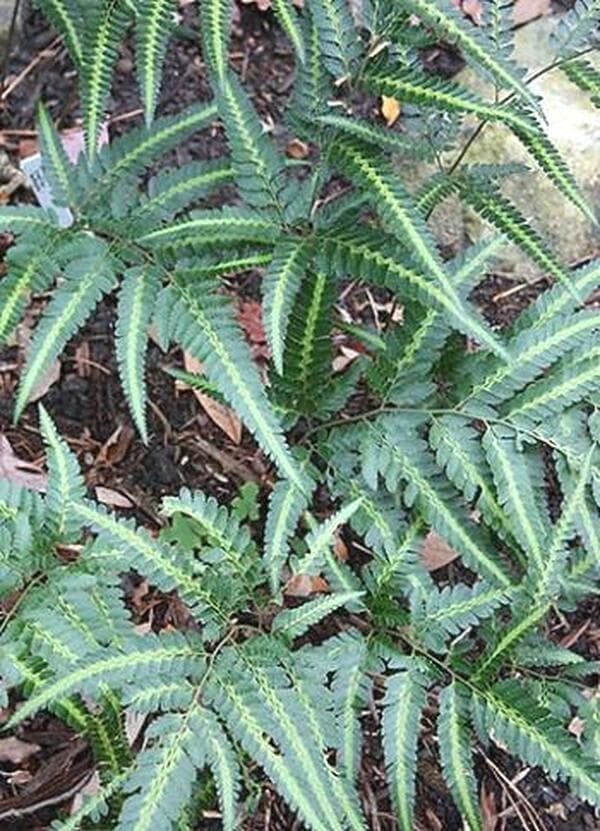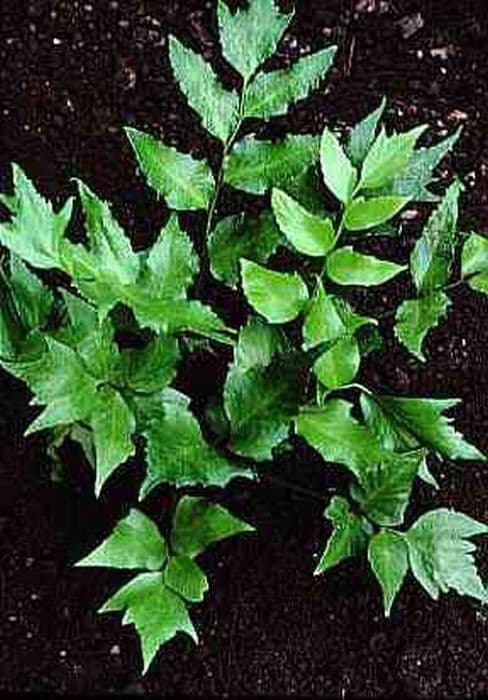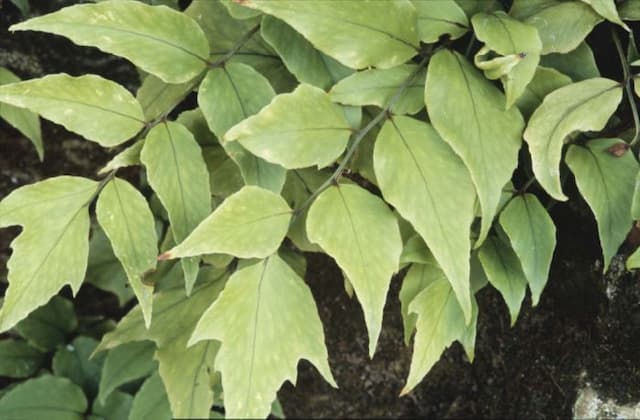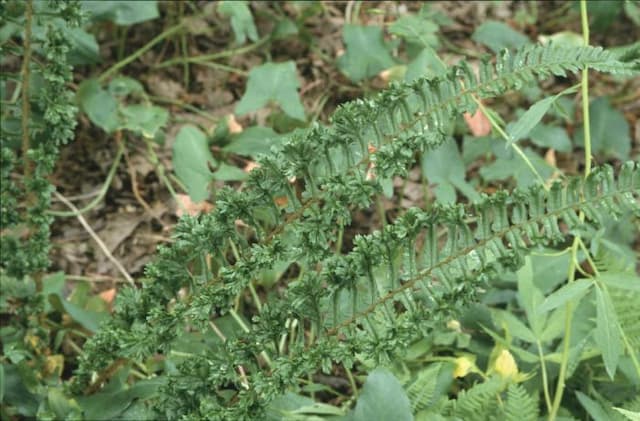Prickly Shield Fern Arachniodes aristata

ABOUT
A reasonably slow-growing, evergreen fern bearing thick, glossy, broadly-triangular, dark green fronds, paler beneath with light green spores, each frond divided into lobed, toothed leaflets or pinnae.
About this plant
 Names
NamesFamily
Dryopteridaceae
Synonyms
East Indian Holly Fern, Japanese Holly Fern
Common names
Arachniodes aristata var. fortunei, Aspidium aristatum, Dryopteris aristata, Lastrea aristata, Phanerophlebia aristata, Rumohra aristata.
 Characteristics
CharacteristicsLife cycle
Perennials
Foliage type
Evergreen
Color of leaves
Green
Height
2-3 feet (60-90 cm)
Spread
2-3 feet (60-90 cm)
Plant type
Fern
Hardiness zones
9
Native area
East Asia
Benefits
 General Benefits
General Benefits- Aesthetic appeal: Arachniodes aristata, also known as East Indian holly fern, adds a lush, green look to gardens and indoor spaces with its glossy, dark green fronds.
- Shade tolerance: It thrives in shaded areas where other plants might struggle to grow, making it ideal for woodland gardens or as an understory plant.
- Low maintenance: East Indian holly fern requires minimal care once established, making it a convenient choice for gardeners of all levels.
- Drought resistance: Although it prefers moist conditions, it can withstand periods of drought once it's well-established.
- Soil erosion control: Its root system helps to stabilize soil, preventing erosion in sloped or unstable areas.
- Evergreen: As an evergreen plant, it maintains its foliage year-round, providing consistent landscape interest.
- Wildlife habitat: Provides shelter and breeding grounds for small wildlife, including beneficial insects.
 Medical Properties
Medical PropertiesThis plant is not used for medical purposes.
 Air-purifying Qualities
Air-purifying QualitiesThis plant is not specifically known for air purifying qualities.
 Other Uses
Other Uses- East Asian themed gardens: East Indian Holly Fern can be utilized in creating or enhancing East Asian inspired garden designs due to its native origin and aesthetic appeal.
- Groundcover: The fern can be used as a groundcover in shaded areas of the garden, where it forms lush, evergreen mats that suppress weeds.
- Erosion control: On shady slopes, its dense root system helps stabilize soil and prevent erosion.
- Outdoor pots: With its elegant fronds, East Indian Holly Fern can be potted and placed in shaded patios or balconies to add greenery to the decor.
- Floral arrangements: Fronds of this fern can be cut and used in floral arrangements for their lasting quality and striking texture.
- Vivariums: The fern works well in the damp, humid environment of vivariums and terrariums, and it is popular among reptile and amphibian enthusiasts.
- Culinary decoration: The non-toxic fronds can be used as a decorative, garnishing element in upscale culinary presentations.
- Green walls or vertical gardens: East Indian Holly Fern can be incorporated into vertical gardens, particularly in low-light indoor areas.
- Textile dyes: Historically, some fern species have been used to derive green dyes, and East Indian Holly Fern could potentially offer similar uses.
- Biomonitoring: Like many ferns, the East Indian Holly Fern might be used in biomonitoring to study the health of forests and ecosystems where it is native.
Interesting Facts
 Feng Shui
Feng ShuiThe East Indian Holly Fern is not used in Feng Shui practice.
 Zodiac Sign Compitability
Zodiac Sign CompitabilityThe East Indian Holly Fern is not used in astrology practice.
 Plant Symbolism
Plant Symbolism- Resilience: Arachniodes aristata, commonly known as the East Indian Holly Fern, can thrive in shaded areas where other plants might struggle, representing the ability to endure and adapt to challenging conditions.
- Protection: With its holly-like leaves, the East Indian Holly Fern is reminiscent of the holly plant, which is often associated with protection and safety, suggesting a symbolic meaning of safeguarding against negative energy.
- Tranquility: The lush green foliage of the East Indian Holly Fern can create an environment of peace and serenity in a garden space, symbolizing calm and relaxation.
- Perseverance: The fern's capability to spread and grow in dense clumps embodies perseverance and the capacity to persist through obstacles.
- Longevity: As an evergreen plant, the East Indian Holly Fern represents everlasting life or immortality, signifying a continuous presence that defies the passing of seasons.
 Water
WaterThe East Indian Holly Fern should be watered regularly but allow the soil to slightly dry out between waterings. It is best to water this plant with about 1 gallon of water every week, but this can vary depending on the humidity and temperature of the environment. It's important to water the plant evenly, avoiding soggy soil, which can lead to root rot. During the warmer months, you may need to water the plant more frequently, while in the winter, less water is required.
 Light
LightThe East Indian Holly Fern thrives in partial to full shade. This plant prefers indirect sunlight or filtered light and should be placed in a spot where direct sun does not reach the foliage, as this can cause the leaves to scorch. An ideal location for the East Indian Holly Fern would be a north-facing window or a shaded area in a room with bright ambient light.
 Temperature
TemperatureThe East Indian Holly Fern does well in average room temperatures, ideally between 60 and 75 degrees Fahrenheit. The minimum temperature this plant can tolerate is around 50 degrees Fahrenheit, and it should not be exposed to temperatures below this, as it may cause damage to the plant. Keeping the fern in its ideal temperature range will ensure robust growth.
 Pruning
PruningPruning the East Indian Holly Fern is essential to maintain its shape and encourage healthy growth. Remove any brown or damaged fronds at the base to improve air circulation and plant appearance. The best time to prune is in spring or early summer when the plant is actively growing. Pruning can be done annually or as needed when leaves become discolored or unsightly.
 Cleaning
CleaningAs needed
 Soil
SoilEast Indian Holly Fern prefers well-draining, loamy soil rich in organic matter with a pH between 6.0 and 7.5. A mix of one part garden soil, one part peat or coco coir, and one part perlite or sand is ideal for potting.
 Repotting
RepottingEast Indian Holly Fern does not need frequent repotting and can be done every 2-3 years or when it outgrows its current container, using the appropriate soil mix.
 Humidity & Misting
Humidity & MistingThe East Indian Holly Fern thrives in high humidity levels, preferably between 60% to 80%, resembling its native tropical habitat.
 Suitable locations
Suitable locationsIndoor
Keep in bright, indirect light and high humidity.
Outdoor
Shade, shelter from wind, ample humidity, and well-draining soil.
Hardiness zone
7-10 USDA
 Life cycle
Life cycleArachniodes aristata, commonly known as the East Indian Holly Fern, begins its life cycle as a spore, which germinates to form a small, heart-shaped gametophyte (prothallus). This gametophyte is bisexual and produces both sperm and eggs within its structure, which, upon fertilization, develop into a new sporophyte—the familiar fern plant. The sporophyte grows from a rhizome and develops fronds that unfurl from coiled structures called fiddleheads. These mature fronds are pinnately compound and have distinctive holly-like leaflets. As the plant ages, it forms spore-producing sori on the underside of the fronds, completing the reproduction cycle. With proper conditions, including shade and moist soil, the East Indian Holly Fern can live for several years, continuing to reproduce and grow in a perennial life cycle.
 Propogation
PropogationPropogation time
Spring-Early Summer
For East Indian Holly Fern (Arachniodes aristata), the most popular method of propagation is through division. This process is typically done in the spring, as the plant emerges from dormancy. The fern is gently taken out of its container, and the root ball is carefully divided into smaller sections, each with an adequate amount of roots and fronds. These sections are then replanted into individual pots filled with a well-draining soil mix. Care should be taken to keep the soil consistently moist but not waterlogged, and the plants should be kept in a shaded or indirectly lit area until they establish. With proper care, these divisions will grow into new, healthy ferns over the course of the growing season.









